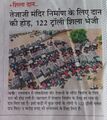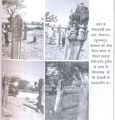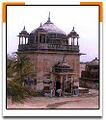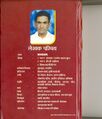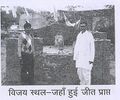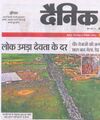Tejaji
| Author: Laxman Burdak लक्ष्मण बुरड़क IFS (R) |
| सूचना: श्री इन्दर राज ज्यानी लोक देवता तेजाजी पर Ph.D. कर रहे हैं. आपके पास तेजाजी से सम्बंधित कोई पुरातात्विक या ऐतिहासिक जानकारी हो तो उनको Mob:9462923558 पर व्हाटसऐप्प करें |
- For information on this topic in Hindi see - Lok Devata Tejaji

Tejaji (तेजाजी) (29.1.1074 - 28.8.1103) was a warrior, social reformer and folk-deity of Rajasthan in Northern India. The pages of history of Rajasthan are full of many heroic events, stories and examples where people put their life and families at risk and kept the pride and upheld moral values like loyalty, freedom and truth etc. Veer Teja was one of those famous persons in the history of Rajasthan.
Variants of name
- Kunwar Teja (कुँवर तेजा) (Rajasthani)
- Teja (तेजा) (Hindi)
- Tej Raj/Teja Raja/Tejaraja (तेजराज)
- Tej Pal/Teja Pala/Tejapala (तेजपाल)
- Tejaji/Teja Ji (तेजाजी) (Hindi)
- Tejaji Maharaja (तेजाजी महाराज)
- Tejo (तेजो) (Rajasthani)
- Tejoji/Tejo Ji (तेजोजी) (Rajasthani)
- Veer Teja (वीर तेजा)
- Vir Teja (वीरतेजा)
Birth of Tejaji
Tejaji is considered to be folk-deity and worshiped in entire Rajasthan, Uttar Pradesh, and Madhya Pradesh by all communities. Tejaji as a historical person was born on in Vikram Samvat 1130 Magh Sudi 14 Thursday 29 January 1074, in the family of Dhaulya gotra Nagavanshi Jat at Kharnal, Nagaur. His father was Tahar Dev (Thirraj), a chieftain of a republic of 24 villages in Kharnal, district Nagaur in Rajasthan, earstwhile called as Sapadalaksha. His mother's name was Ram Kunwari, daughter of Dulhan Ji Sodhi (Jyani), Chieftain of the republic Tyod (Kishangarh, Ajmer). Mother and father were worshippers of Shiva. His mother Ramkunwari did not get any issue for 12 years after marriage so she went to Tyod in V.S. 1118 and worshipped Nagaraja at Tyod for the birth of son. In V.S. 1129 she was got a boon from Nagaraja. She got son with the blessings of Nagaraja. His aura at the birth was so strong that he was named Teja.[1]
History of Dhaulya clan
The Dhaulya clan ancestors of Tejaji were settled in Khilchipur in Madhya Pradesh during Ramayana period. Later due to political reasons they came from Khilchipur to Gohad and then to Dholpur. Tejaji's ancestor Dhavalapala founded Dholpur and gave name Dhaulya to his clan. Shvetanaga was same as Dhavalanaga. Some of their ancestors left Dholpur and came to Jayal. [2]
Jayal was the centre of Khichi Chauhans. They ruled here for about 1000 years. Manakrao son of Asaraja Chauhan (1110-1122) is considered the originator of Khichi branch of Chauhans. Manakrao had visited Jayal in 1111 AD. [3]
As per record of Ram Singh Khichi, bard of Khichi people, the family tree of Khichi rulers of Jayal is as under: - 1. Manak Rao, 2. Ajay Rao, 3. Chandra Rao, 4. Lakhan Rao, 5. Govind Rao, 6. Ramdev Rao, 7. Maan Rao 8. Gundal Rao, 9. Someshwar Rao, 10. Lakhan Rao, 11. Lal Singh Rao, 12. Laxmi Chand Rao 13. Bhom Chand Rao, 14. Benn Rao, 15. Jodhraj[4]
Gundal Rao was contemporary of Prithvi Raj.[5]
Tejaji's ancestors were Nagavanshi descendant of Shvetanaga, who had five kingdoms in Central India, namely - 1. Khilchipur, 2. Raghaugarh, 3. Dharnawad, 4. Garhkila (Kilkila), and 5. Khairagarh.[6]
In Jayal Udayaraja developed differences with Kala clan people which led to a war in which Kala Jats of Jayal were defeated. But left Jayal and settled at Dholi Deh. Udayaraja occupied Kharnal from Khoja-Khokhar people and made his capital in V.S. 1021 (964 AD). Earlier name of Kharnal was Karnal but linguistic difference changed it to Kharnal. These facts are recorded in the Bahi of Bhairu Ram Bhat of Degana (Badwa of Dhaulya clan). [7]
Kala Jats had 27 villages around Jayal. Kalas were descendant of Kalanaga/Asitanaga. They were settled in Jayal since ancient times. They were known as Kalas of Jayal. [8]
Tahardev (born: ?-death:1082 AD) or Thiraraja , son of Vohitrāj, was Dhaulya clan ruler of Kharnal and father of Tejaji. Taharji married with Ramkunwari in V.S. 1104 (=1047 AD) daughter of Dulhan Sodhi (Jyani) of Tyod. But there was no issue from Ramkunwari for 12 years. [9]
Later Taharji, father of Tejaji, married with Rami Devi daughter of Karnoji Fidoda/Phardoda of village Koyalapatan (Athyasan) in V.S. 1116 (=1059 AD). [10]
Vohitaraja was grandfather of Tejaji. His eldest son Tahardev died before him. Vohitaraja had to see the administration of Kharnal republic after death of Tahardev. In some folk songs name Baksaji is also mentioned who was same as Bohitaraja. [11]
Tahardev and his brother Askaran were killed by Baliya Kala of Jayal and Kaliya Meena of Chang in V.S. 1139 (1082 AD) at Kharnal. [12]
Dhaulya chieftains were integral part of Chauhan confederation. After Naradeva Chauhan, Vigraharaja II provided strong opposition to the Muslim invader Subuktigin in 997 AD. Govindaraja or Govindadeva III repaired Nagaur Fort in 1053 AD. Govindadeva III changed his capital from Nagaur to Sambhar when attacks from Muslims increased. Later Ajayapala Chauhan shifted his capital from Sambhar to Ajmer in 1123 AD. Ajayapala got land of the Mer people inhabitants of this area and combined with his own name Ajay called his capital Ajmer. Ajayapala Chauhan handed over the kingdom to Arnoraja (1133-1153) and became a saint. [13]
Dhulia rulers of Indergarh : There is mention of Dhulia rulers by Ram Swarup Joon[14] in Badli area of Haryana. Badra Sen was an officer in the army of Prithvi Raj. Badli Pargana was his estate. He belonged to a Dhulia family of Indergarh. Before the Chauhan rule, Bhadra, Ajmer, Indergarh etc. were the capitals of the Gor Jats. After the death of Prithvi Raj there was chaos in the country. The Khokhar Jats slayed Mohammad Ghori near Multan. There was a woman named Bodli. The village was named Badli in her honour. Sant Sarang Dev's samadhi (shrine) still exists in Badli and is widely worshipped.
Dhavaladeva in Orissa: Tejaji was born in the 21st generation of Dhaulya dynasty epi-person Mahabala. If we take period of one generation to be 30 years then the period of Mahabala comes around 500 AD. This was around the end of Gupta Empire. The Gupta Empire (320 - 540 AD) was one of the largest political and military empires in ancient India. It was ruled by the Gupta dynasty from around 240 to 550 CE and covered most of northern India and what is now eastern Pakistan and Bangladesh. During this period it was considered a Great power. Jat Origin of Guptas is advocated by K P Jayaswal[15][16], Bhim Singh Dahiya[17], Hukum Singh Panwar[18], Tej Ram Sharma[19], B.G. Gokhale[20] Dalip Singh Ahlawat[21] The period of this Jat Empire is considered to be the Golden period in the History of India. Mahabala, the primeval man of Dhaulya clan ancestry was probably a feudatory of Guptas probably in the eastern part around Kalinga. This fact get strength from the existence of Dhauli (धोली) hills located on the banks of the river Daya, 8 km south of Bhubaneswar in Orissa. Dhaulya clan of Jats probably get name from Dhauli.[22] It is a hill with vast open space adjoining it, and has major Edicts of Ashoka engraved on a mass of rock, by the side of the road leading to the summit of the hill. Dhauli hill is presumed to be the area where Kalinga War was fought. The Dhavaleswar temple is one of the larger temples in Orissa. Dhawaleshwar Temple is located on the shoreline of river Mahanadi, 37 km from Cuttack city, Orissa, India. It is devoted to Lord Shiva.[23] According to Dr Naval Viyogi remains of their offshoot, the royal family of Dhavaladeva is still existing at Dalbhumigarh near Kharagpur in Orissa. [24] There is a need to further research the history of ancestors of Tejaji as given in the Genealogy of Tejaji.
Genealogy of Tejaji
Mansukh Ranwa[25] has provided the Genealogy of Dhaulya rulers. The primeval man of their ancestry was Mahābal, whose descendants and estimated periods calculated @ 30 years for each generation are as under:
- 1. Mahābal (महाबल) (480 AD)
- 2. Bhīmsen (भीमसेन) (510 AD)
- 3. Pīlapunjar (पीलपंजर) (540 AD)
- 4. Sārangdev (सारंगदेव) (570 AD)
- 5. Shaktipāl (शक्तिपाल) (600 AD)
- 6. Rāypāl (रायपाल) (630 AD)
- 7. Dhawalpāl (धवलपाल) (660 AD)
- 8. Nayanpāl (नयनपाल) (690 AD)
- 9. Gharṣanpāl (घर्षणपाल) (720 AD)
- 10. Takkapāl (तक्कपाल) (750 AD)
- 11. Mūlsen (मूलसेन) (780 AD)
- 12. Ratansen (रतनसेण ) (810 AD)
- 13. Śuṇḍal (सुण्डल) (840 AD)
- 14. Kuṇḍal (870 AD)
- 15. Pippal (पिप्पल) (900 AD)
- 16. Udayarāj (उदयराज) (930 AD) (Udayaraja Dhaulya defeated Kala Jats of Jayal and occupied Kharnal in 964 AD and made his capital)[26]
- 17. Narpāl (नरपाल) (960 AD)
- 18. Kāmrāj (कामराज) (990 AD)
- 19. Vohitrāj (वोहितराज) (1020 AD)
- 20. Thirarāj (थिरराज) (1050 AD) or Tahardev (ताहड़देव)
- 21. Tejpal (तेजपाल) (1074- 1103 AD)
Sant Kanha Ram[27] writes that This genealogy is based on Badwa of Dhaulya clan Shri Bhairu Ram Bhat (died: 1996 AD) of Degana. Sanwat Ram Bhat provided names of brothers of Tejaj's father Tahar Dev: 1. Narpal, 2. Jaisi, 3. Dhursi, 4. Budhraj, 5. Askaran and 6. Shersi. Out of them Askaran and Budhraj became Jhunjar, died fighting with enemies. Deoli of Askaran is is situated in the north of village Kharnal.
Taharji had six sons namely - Tejaji, Raṇaji, Guṇaji, Maheshji, Nagji, and Rūpji. He had one daughter named Rājal . Rājal was married. Rājal was married to Jogaji Siyag of village Tabījī (तबीजी). Rājal had become sati with his brother Tejaji.
Tejaji's marriage with Pemal
Pemal (पेमल) (1074-1103) was wife of Tejaji. Pemal was daughter of Raimal of Jhanjhar gotra, chieftain of Paner. She was born in V.S. 1131 (1074 AD) on Buddha Purnima. She was married to Tejaji in the early childhood. She could meet with Tejaji only in the last days of her life and became Sati when Tejaji died fighting with the enemies for the protection of cows. [28]
Tejaji's marriage with Pemal took place in Pushkar, Ajmer in 1074 AD when Teja was 9 months old and Pemal was 6 months old. Marriage took place at Pushkar Ghat on Pushkar Purnima of V.S. 1131. Pemal's mama named Khaju Kala of Jayal had enmity with Dhaulya family and was not in favour of this relationship. A dispute arose between Khaju Kala and Tahar Dev and Tahar Dev killed Khaju Kala with sword. Tejaji's uncle Askaran was also present on this occasion. [29]
Lilan Ghori
Lilan (लीलण) (1074-1103 AD) was the name of mare of folk deity Tejaji. Lilan was born in the same year 1074 AD in which Tejaji was also born. Lilan always accompanied Tejaji since childhood and died with Tejaji in 1103 AD.
Birth of Lilan : A Horse trader Lakhi Banjara from Sindh was passing through Kharnal in V.S. 1131 (1074 AD) when Lilan was born on the auspicious day of Akshaya Tratiya at 12 am. Her mother died soon after Lilan's birth. Lakhi Banjara could not carry Lilan in this stage so he handed over Lilan to Tahar Dev, the chieftain of Kharnal. Lilan grew up with Tejaji. [30]
When Tejaji was taking last breath at Basak Nag's Bambi, Sursura, after war with Meenas of Chang and bringing all the cows of Lachha Gujari back from Meenas, Tejaji gave his last instruction to Lilan to carry message of his death to Kharnal. Lilan did it sincerely. Lilan stopped at one place for rest at Khariya Talab of Parbatsar, Nagaur in her entire journey from Sursura to Kharnal. She reached Kharnal on Bhadwa Sudi Gyaras V.S. 1160 (Sunday 29 August 1103 AD), conveyed message to family members symbolically through tears and died. [31]
Lilan Ghodi Temple: Out side the village Kharnal there is a small temple of Tejaji at a distance of 1.5 km from big temple on the bank of Dhuwa talab. It is known as Ghodi temple where the Lilan ghodi of Tejaji reached and brought about the message of martyrdom of Tejaji. This temple is located in Dhuwa Johar, the water of which is used for drinking for villagers.
Teja Path: Kharnal to Paner

Sant Kanha Ram[32] writes that the route Tejaji followed in his journey from Kharnal to Paner is called Teja Path.
Tejaji started his journey for Paner from Kharnal on Bhadwa Sudi Saptami V.S. 1160 or 25 August 1103.
Villages in Teja Path : Kharnal - Parara (Parasara)- Beenthwal - Soliyana - Mundwa - Bhadana - Junjala - Kuchera - Lunsara (Lunera) (Night Halt) - Bhawla - Chardas - Kaman - Habchar - Noond - Midian - Altawa - Harnawa - Bhadwa - Mokalghat - Paner...All these villages are associated with Tejapath and considered sacred.



Tejaji made a night halt at village Lunsara, which is situated at a distance of 60 km from Kharnal in east direction. The village at that time was inhabited by Dudi and Chharang Gotra Jats, But these clans are not inhabiting the village at present. They migrated elsewhere. There 1500 families at present and Jat Gotras are Nagwaria, Jakhar, Saran.
It is believed that the old village was ruined due to curse of Nathji.
Ancient village had 140 villages but all these were burried in earth. The place is known by name Sar.
Rain started after Tejaji left behind Bhadwa village. East of Bhadwa and west of Parbatsar are the Mandan - Malas Arrawali Ranges and water coming from there forms Paner River which stopped the journey of Tejaji. Tejaji could cross the Paner River with the help of Lilan.
Story of Tejaji's sacrifice

Tejaji's halsotia and bhabhi's taunts - As per the tradition in that area, the chieftain had to initiate the ploughing of fields after first rains in jyestha month. Tejaji's mother asked Tejaji to do the halsotiya (initiation of ploughing) in the fields. Tejaji went to fields and started ploughing. His bhabhi became late in fetching his food locally called Chhak, which angered Tejaji. On Tejaji's anger she taunted that his wife was in her father's home and it was shame on his part. This prompted him to go to bring his wife from in-laws. [33][34]
Bring Rajal first - Bhabhi asked Tejaji that before he brings his wife Pemal, he should bring his sister Rajal so that she can receive Pemal on her first arrival to Kharnal. Tejaji did not know that he was married. He asked his mother who told that Tejājī was married to Pemal in early childhood at Pushkar with the daughter of Rai Mal Jat of Jhanjhar gotra, the chief of village Paner. During marriage at Pushkar there was a dispute between Pemal's māmā Khaju Kala of Jayal and Tahar Dev, father of Tejaji, in which mama of Pemal was killed. [35]
War with Meenas - When Tejaji was on way to village Tabiji to bring his sister Rajal, he was attacked by Meena sardar. Tejaji inserted the bhala in ground and challenged the enemies to take it out. Enemies could not do it and ran away. There was a war and Tejaji was victorious. He reached village Tabiji, got permission of her sister's husband Jogaji Siyag and brought Rajal to Kharnal. [36]
Tejaji reaches Paner - Next day early in the morning he mounted his mare Līlaṇ with palāṇ and started journey to Paner to bring his wife Pemal. It was a difficult journey, but he crossed all the nalas and Paner River running full of water due to heavy rains. He reached Paner by evening but gates of the fort were closed so stopped at Raimal Muhta's garden near Paner. [37]
When Tejaji reached Raimal Muhta's house at that time his mother-in-law was milking cows. The cows got disturbed due to Tejaji's brisk entry on his mare. His mother-in-law could not recognize Tejaji and cursed him that he be bite by a black snake as he has disturbed her cows. [38]Tejaji got angry over this comment and decided to return without Pemal. Pemal became very annoyed on this behavior of her mother and requested his father and brother to stop Tejaji from returning back. Lachha requested and told the story of agony of Pemal. Tejaji stays back at Lachha's house and meets Pemal first time. [39][40]
Lachha Gujari's cows stolen - Lachha Gujari was a friend of Pemal. Her house was at 'Rangbari Ka Bas' about 2 km from Paner. Lachhan Gujari helped Pemal to meet with Teja. For this Lachhan rode on camel and went to Teja facing many clashes with Meena sardars en route. Lachhan reached Teja and gave Pemal's message that if Tejaji does not come she will die. Parents of Pemal had decided to re-marriage her with some other person. At this time Pemal was going to die but saved by Lachhan. Tejaji came to Paner and saw her there. Pemal was a beautiful and attractive girl. They were talking with each other that they heard knock of Lachha Gujari. Lachha told Tejaji that Meenas of Chang have taken away all her cows and there is no body in this to help. Tejaji mounted his mare Lilan and started alone to fight with dacoits, who had taken away Lachha's cows. [41] [42]
War with Meenas
Tejaji brings back cows - Tejaji assured Lachha that he will do his duty as Kshatriya and bring her cows back. Tejaji mounted on Lilan and took all five weapons with him. Pemal insisted on going with him. Teja found that the cows of Lachhan Gujari were atolen by Kaliya Meena sardar's men. He will go alone and defeat them. Tejaji, who was made to extend help to needy, decided to bring back those cows alone and thus left Pemal behind. [43][44]
The myth is that he encountered a Basak Nag burning in fire on the way and that was saved by Teja. That snake cursed Teja and wanted to bite Teja. Teja assured that he will come back after taking back cows. Basak Nag asked for the witness that he will come back. Tejaji said - Sin, Moon and the Khejri tree are my witness. [45] [46]
Tejaji had war with the Meenas in the valley of Chang at about 15 km distance from Sursura near the Mandawaria village. He killed all 350 Meenas. It was an unparallel war in history, Tejaji alone fighting with 350 enemies. Tejaji was victorious and got back the cows. [47] [48]
He killed many Meenas in the war. He was badly wounded in the process to bring Gujari's cows back from Meenas. Veer Teja was man of words. He brought all cows back to Paner where Lachha told that Kanan Kerda (one eyed male calf) has yet not come back. Tejaji goes back to the hills where Meenas were hiding. This time he was encountered with about 750 Meenas. He attacked them and brought back Kanan Kerda (one eyed calf). Meenas attacked Tejaji and was seriously injured. He killed many Meenas in this war whose deolis are there in the Mandawaria hills. He came back victorious. [49][50]
Death of Tejaji
A man of word: After returning cows to Lachha, Tejaji kept his words and produced himself before the Basak Naga. Basak Naga did not find any unwounded place on the body of Teja so he offered to bite on tongue. The snakebite was on tongue of Teja. Basak Naga was very much pleased with Teja that he kept his words. Basak Naga gave a boon that Teja would be a deity of Kaliyuga, would be worshipped in every house. Remembering his name would treat snake bite. Farmers who remember Tejaji would get plenty of foodgrains. [51]
When Tejaji was about to die he called a raibari Asu Dewasi to send a message to Raimal Mehta and Pemal about his death. He also sent Lilan to carry his message to Kharnal. [52] [53]
Tejaji died on Bhadrapada Shukla Dashmi Saturday V.S. 1160 or 28 August 1103. [54] The date of martyrdom of Tejaji is celebrated as Teja Dashmi.
Pemal sat on the pyre with Tejaji in her lap and became sati at place called Sursura. Tejaji Muktidham Temple has been constructed at this site in Sursura. [55]
Lilan left departed for Kharnal. Lilan was very said and much tired so she stopped for some rest at the banks of Khariya talab of Parbatsar village for some time and went straight to Kharnal. The people of Kharnal could read from the face of Lilan that Tejaji was no more. Tejaji’s sister Rajal became sati on the eastern johad near Kharnal village. A temple has been constructed on this site in the name of Rajal. This is a unique example of sister becoming sati on the death of his brother.[56]
Lilan also died after this and its temple has been constructed on the bank of southern talab near Kharnal.[57]
Personality of Tejaji
A saint - Veer Teja was a great saint. A large number of temples of Veer Teja have been built in entire Rajasthan. It is believed that if a person suffering from snakebite goes to samadhi of Teja or puts a chord (tanti) in Tejaji's name, he is cured. Tejaji is a demigod with the power to spare from death any snakebite victim who ties an amulet in Tejaji's name. And to this day the priests of Tejaji's temples go into trance and suck the poison out of snakebites and then tie a thread around the wrist or ankle of the victim. And it is believed that no one so treated will die from the bite.
Tejaji Smarak Kharnal
Tejaji Smarak - Tejaji Smarak is under construction on the main road near the village. A grand statue has been installed and rest of the works are in progress. Rs 50 lakhs were donated by Mrs Vasundhara Raje Sindhia, the Ex. C M of Rajasthan and Rs 50 Lakhs has been collected by donations from the public for the completion of this Tejaji Smarak.
Tejaji fairs
Tejaji Fairs are held in temple towns that have temples dedicated to Tejaji on on the occasion of Teja Dasmi (Bhadrapada Shukla Dashmi) in various cities of Rajasthan, Madhya Pradesh and Haryana. Tejaji martyred himself on Bhadrapada Shukla Dashmi in V.S. 1160 (Saturday 28 August 1103 AD) fighting with the enemies for the protection of cows at Sursura, Kishangarh, Ajmer. Sursura is considered as Mukti Dham. A large fair, Mela Tejaji, Takes place on the eleventh lunar day of Bhadrapad Shukla Paksh (Aug.-Sept.) every year in village Parbatsar, District Nagaur in Rajasthan. On this date the state officers of Parbatsar bring the flag Tejaji with Govt honour. Before raising the flag an official announcement is made - Jat Aao Jhanda Uthao (जाटो आओ झण्डा उठाओ). After this all Jats raise the flag and an honour of 11 guns salute is given on this occasion. [58] A grand Tejaji fair is organized on Teja Dashmi in Ani village in Jaipur district every year. [59]
Tejaji fairs in Rajasthan: Tejaji fairs at various places in Rajasthan are held on Teja Dashmi.
- Ajmer (Usarigate, Datanagar Jatia Hills, Topdara Meghvanshi Mohalla, Ramnagar)
- Amalsara (Baran)
- Ani (Jaipur)
- Antah (Baran)
- Antarda (Bundi)
- Bamori Kalan (Baran)
- Bansi Dugari (Bundi)
- Baran (Dolmela Maidan,
- Beawar (Ajmer)
- Bhilwara : (Tejajichowk, Bhilwara)
- Bohat (Baran)
- Chhipabarod (Baran)
- Chittorgarh (Pratapnagar)
- Harnawada Shahji (Baran)
- Indas (Nagaur)
- Jaloda Tejaji (Baran)
- Jhotwara (Jaipur)
- Khajwana (Nagaur)
- Kharnal (Nagaur)
- Kota
- Koyla (Baran)
- Mangrol (Baran)
- Mundwa (Nagaur)
- Palaytha (Baran)
- Palaytha (Baran)
- Palaytha (Baran)
- Palaytha (Baran)
- Palaytha (Baran)
- Palaytha (Baran)
- Parbatsar (Nagaur)
- Sarthal (Baran)
- Seeswali (Baran)
- Shahbad (Baran)
- Shahbad (Baran)
- Sursura (Ajmer)
- Todgarh (Ajmer)
- Umariya Baran (Baran)
Tejaji fairs in Madhya Pradesh: Many fairs are held in Malwa region of Madhya Pradesh on the occasion of Teja Dasmi (Bhadrapada Shukla Dashmi) to mark the martyrdom of Tejaji. Malwa has large number of followers of Tejaji and fairs are held in large number of villages there on this date.
- Aron (Guna)
- Bhamawad (Guna)
- Magroda (Guna)
- Roshnabad (Dewas)
- Ruthiyai (Guna)
- Tarana (Ujjain)
- Ujjain ([[Badnagar] Road]
Tejaji Temples

- Veer Jujharu Tejaji ka Mandir Kharnal, Nagaur, - There is a big temple of Tejaji in Kharnal facing north direction. In the temple there is a brass statue of Tejaji with mukut and kalgi and a bhala in hand. On the left side there is a brass statue of a ghora decorated with chhevati. On right side is a statue of snake and a statue of Tejaji's sister Rajal or baghal. People of this village tell that the statue of Tejaji had come out of soil naturally. This statue is believed to be about 1000 year old.
- Shree Veer Teja Mandir, Nai mandi, Ghadsana, Anupgarh (Ganganagar), Rajasthan
- Veer Tejaji ka Mandir Pura Rajgarh (Beora), Madhya Pradesh
- Tejaji Muktidham Temple Sursura -
- Tejaji Chauk Temple Complex Bhilwara -
- Usari Gate Tejaji Devri at Ajmer -
- Bhairav Garh Siddhvat Temple Ujjain -
- Badgaon Bandh (Udaipur) - Teja Ji Temple
- Sulawad Dhar Madhya Pradesh - Teja Ji Temple
- Makhawad, Shajapur district in Madhya Pradesh - Teja Ji Temple
- Hatod (हातोद ) is a village in Indore tahsil in Indore district in Madhya Pradesh.
-
तेजाजी मन्दिर निमार्ण, दैनिक भास्कर 03.09.2023
-
Veer Tejaji Movie
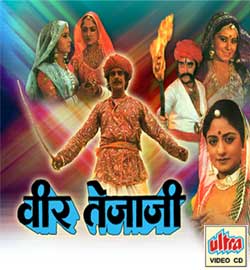
Veer Tejaji is a Rajasthani Language movie , based on the life of Tejaji, made in the 1982. The movie was a big commercial success in its time and gave a significant fillip to the Rajasthani movie industry. It shows the life of Jats, Meenas and Gujars and their position in the society in eleventh century. The writer and Director of the movie was Nawal Mathur. Producer was Ramraj Nahta. Star Cast Rameshwari, Deepak Seth, Nilu etc. Deepak Seth has played role of Tejaji and Rameshwari as Pemal, the wife of Tejaji.
In real life, Punjabi actor Deepak Seth and Telugu actress Rameshwari are married to each other. They have two sons together. Both husband and wife started producing Punjabi films in 2007.[60]
Taj Mahal: a Tejaji temple
Main article: Tajmahal is a Hindu Temple Palace

There are large number of Tejaji temples in India in the states of Rajasthan, Gujarat, Madhya Prdesh, Uttar Pradesh and Haryana. The book, Taj Mahal: The True Story (ISBN 0-9611614-4-2), written by Purushottam Nagesh Oak or P. N. Oak, the founder-president of the Institute for Rewriting Indian History. The book seeks to prove that the Taj Mahal was originally a Hindu temple whose existence predated the Mughal Empire. The people who dominate the Agra region are Jats. Shiva bears thousand names. There are two names based on Teja (Tejo in Rajasthani) in this list, namely: Tejomayadyutidhara, Tejonidhi. Jats know Shiva by the name Tejaji. The Jat special issue of The Illustrated Weekly of India (June 28, 1971) mentions that the Jats have the Teja Mandirs, i.e., Teja Temples. This is because Teja-Linga is among the several names of the Shiva Lingas. From this it is apparent that the Taj-Mahal is Tejo-Mahalaya, The Great Abode of Tejaji.[61]
The following points are among the pieces of evidence presented:
- Carbon dating of samples taken from the doorway of the Taj Mahal from the side of the Jamuna rivers revealed that the door was 300 years older than the period of Shah Jahan. The carbon dating was arranged by Marvin Miller, an economist in New York.
- Johan Albert Mandelso, a European traveller who visited Agra in 1638, seven years after the death of Mumtaz Mahal, vividly described the life of the city in his memoirs, but makes no reference to Taj Mahal or any large construction activity going on to build it.
- Peter Mundy, an Englishman, visited Agra within a year of Mumtaz’s death. From his writings, it appears that the Taj Mahal was already a noteworthy building well before Shah Jahan came to power.
Postal Stamp on Tejaji
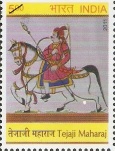

India Postal Department released a special on commemorative stamp on Folk deity Veer Tejaji Maharaj at Kharnal in Nagaur Distt of Rajasthan on Tejadasani: Thursday, September 7, 2011. Union Minister Sachin Pilot released the stamp in a function in presence of thousands of people. The ruling Congress state President and former Minister Dr Chandrabhan, sitting Lok Sabha member Jyoti Mirdha, former Minister Harendra Mirdha and several dignitaries were present on the occasion.[62]
Teja Song's Importance

The Teja Song is sung by farmers of Rajasthan for better rainfall and good production of agricultural crops. It is based on rāg malhar. A chapter on importance of Teja song has been introduced by Cambridge University.
लोक देवता तेजाजी
लोक देवता तेजाजी पर हिन्दी में जानकारी के लिए देखें Lok Devata Tejaji
See also
Listen Tejaji songs
Gallery of Images of Tejaji
-
Tejaji's II Nanihal Athyasan
-
Bungari Mata (Rajal) Temple, Kharnal
-
Ruined Chang village of Meenas
-
Ruined Chang village of Meenas
-
Original village Chang
-
Gain Talab
-
Govind Deo Chauhan's Inscription (1053 AD) near Thal, Singara, Raghunathpura, Balyas
-
Jhanjholao Talab Paner
-
Tejaji's Protector Kala Bhainru, Sursura
-
Lilakhur Nhalsa (लीलण के खुर का नाल)
-
Lilan Ghori of Tejaji
-
Trace of Lilan Ka Ghutna
-
Mandawariya hill war spot Deoli
-
Mandawariya hill war spot
-
Mandawariya hill war spot Deoli
-
Mokal Ghat in west of Parbatsar
-
Paner City - Tejaji's Sasural
-
Tejaji crossing Paner River
-
Parbatsar Kharia Talab
-
Sursura Village View
-
Front Cover of Book
-
Back Cover of Book
-
Tejaji Janmdham - Kharnal
-
Tejaji Grand Statue at Kharnal
-
Tejaji Temple Kharnal
-
Bungari Mata (Rajal) Talab Kharnal
-
Tejaji Ka Nanihal Tyod
-
Tejaji statue in temple at Kharnal
-
Tejaji Temple, Bharnai
-
Tejaji Temple, Antarda
-
Tejaji Temple, Athyasan
-
Tejaji Temple, Beawar
-
Tejaji Temple, Dugari
-
Tejaji Temple, Khajwana
-
Tejaji Temple, Paner
-
Tejaji Temple, Parbatsar
-
Tejaji Temple, Sherpur Indore, Madhya Pradesh
-
Tejaji Temple, Sursura
-
Tejaji Statue, Mundwa
-
Tejaji Statue, Sursura
-
Tejaji Statue, Sursura
-
Tejaji's Victory Spot, Tolamal
-
Tejaji Yatra: Hemraj Bhagirath Bajdolia, Hanumanpalia, Ratlam
-
Tejaji
-
Tejaji
-
Tejaji Mandir Pakistan
-
Further reading
- Mansukh Ranwa: Kshatriya Shiromani Vir Tejaji (क्षत्रिय शिरोमणि वीर तेजाजी), 2001, J C Ranwa Prakashan, Jyotinagar, Piprali Road, Sikar Rajasthan. Ph. 11572-240746
- Dr Mahendra Singh Arya, Dharmpal Singh Dudi, Kishan Singh Faujdar & Vijendra Singh Narwar: Ādhunik Jat Itihasa (The modern history of Jats), Agra 1998
- Thakur Deshraj: Jat Itihasa (Hindi), Maharaja Suraj Mal Smarak Shiksha Sansthan, Delhi, 1934, 2nd edition 1992.
External links
- TEJAJI AARTI -2 BY KANHA RAM
- ऊँट पर उकेरी तेजाजी कथा
- तेजा दशमी-2020 पर लोकसभा अध्यक्ष श्री ओम बिड़ला द्वारा शुभकामनायें
- तेजाजी का लेटेस्ट DJ सांग 2017 !! रिम झिम बरसे भादवा
- Veer Teja Maharaj Ki Katha Video
- http://en.wikipedia.org/wiki/Veer_Teja
- http://www.tripsintoindia.com/martin6.htm
- http://www.webindia123.com/Madhya/festivals/festivals.htm
- http://ultraindia.com/movies/filmography/filmography.php?choice=1&na=VEER%20TEJAJI&set=set
- http://www.virginia.edu/soasia/eventsprog/indiaprogram/documents/faculty_staff_bios.doc
- THE TAJ MAHAL IS TEJOMAHALAY-A Hindu Temple, By P. N. Oak
- http://nagaur.nic.in/tourism.htm
- https://www.facebook.com/vishvendra.choudhary.547
References
- ↑ Sant Kanha Ram: Shri Veer Tejaji Ka Itihas Evam Jiwan Charitra (Shodh Granth), Published by Veer Tejaji Shodh Sansthan Sursura, Ajmer, 2015,pp.166-172
- ↑ Sant Kanha Ram: Shri Veer Tejaji Ka Itihas Evam Jiwan Charitra (Shodh Granth), Published by Veer Tejaji Shodh Sansthan Sursura, Ajmer, 2015. p.62
- ↑ Sant Kanha Ram: Shri Veer Tejaji Ka Itihas Evam Jiwan Charitra (Shodh Granth), Published by Veer Tejaji Shodh Sansthan Sursura, Ajmer, 2015. p.157
- ↑ Sant Kanha Ram: Shri Veer Tejaji Ka Itihas Evam Jiwan Charitra (Shodh Granth), Published by Veer Tejaji Shodh Sansthan Sursura, Ajmer, 2015. p.158
- ↑ Sant Kanha Ram: Shri Veer Tejaji Ka Itihas Evam Jiwan Charitra (Shodh Granth), Published by Veer Tejaji Shodh Sansthan Sursura, Ajmer, 2015. p.158
- ↑ Sant Kanha Ram: Shri Veer Tejaji Ka Itihas Evam Jiwan Charitra (Shodh Granth), Published by Veer Tejaji Shodh Sansthan Sursura, Ajmer, 2015. pp.157-158
- ↑ Sant Kanha Ram: Shri Veer Tejaji Ka Itihas Evam Jiwan Charitra (Shodh Granth), Published by Veer Tejaji Shodh Sansthan Sursura, Ajmer, 2015. p.63,158
- ↑ Sant Kanha Ram: Shri Veer Tejaji Ka Itihas Evam Jiwan Charitra (Shodh Granth), Published by Veer Tejaji Shodh Sansthan Sursura, Ajmer, 2015. p.158
- ↑ Sant Kanha Ram: Shri Veer Tejaji Ka Itihas Evam Jiwan Charitra (Shodh Granth), Published by Veer Tejaji Shodh Sansthan Sursura, Ajmer, 2015. p.160
- ↑ Sant Kanha Ram: Shri Veer Tejaji Ka Itihas Evam Jiwan Charitra (Shodh Granth), Published by Veer Tejaji Shodh Sansthan Sursura, Ajmer, 2015. p.160,164
- ↑ Sant Kanha Ram: Shri Veer Tejaji Ka Itihas Evam Jiwan Charitra (Shodh Granth), Published by Veer Tejaji Shodh Sansthan Sursura, Ajmer, 2015. p.159
- ↑ Sant Kanha Ram: Shri Veer Tejaji Ka Itihas Evam Jiwan Charitra (Shodh Granth), Published by Veer Tejaji Shodh Sansthan Sursura, Ajmer, 2015. p.185
- ↑ Sant Kanha Ram: Shri Veer Tejaji Ka Itihas Evam Jiwan Charitra (Shodh Granth), Published by Veer Tejaji Shodh Sansthan Sursura, Ajmer, 2015. p.77
- ↑ Ram Swarup Joon: History of the Jats/Chapter V, p.87
- ↑ An Imperial History Of India/Gauda and Magadha Provincial History, p.53
- ↑ JRAS, 1901, P. 99; 1905, P. 814; ABORI XX P. 50; JBORS, xix, P. 113-116; vol xxi, P. 77 and vol xxi, P. 275
- ↑ Jats the Ancient Rulers (A clan study)/The Empire of the Dharan Jats, Misnamed Guptas,pp. 177-188
- ↑ Hukum Singh Panwar (Pauria): The Jats:Their Origin, Antiquity and Migrations, pp.137-138
- ↑ Tej Ram Sharma:Personal and geographical names in the Gupta inscriptions, pp. 16-17
- ↑ B.G. Gokhale, Samudragupta, Life and Times, pp. 25-26.
- ↑ जाट वीरों का इतिहास: दलीप सिंह अहलावत, pp.492-494
- ↑ Mahendra Singh Arya et al.: Ādhunik Jat Itihas, Agra 1998,p.258
- ↑ Dhawaleshwar Temple, Orissa Tourist Places
- ↑ Dr Naval Viyogi: Nagas – The Ancient Rulers of India, p. 158
- ↑ Mansukh Ranwa: Kshatriya Shiromani Veer Tejaji, 2001, p.13
- ↑ Sant Kanha Ram:Shri Veer Tejaji Ka Itihas Evam Jiwan Charitra (Shodh Granth), Published by Veer Tejaji Shodh Sansthan Sursura, Ajmer, 2015. pp.62-63
- ↑ Sant Kanha Ram: Shri Veer Tejaji Ka Itihas Evam Jiwan Charitra (Shodh Granth), Published by Veer Tejaji Shodh Sansthan Sursura, Ajmer, 2015. p.157
- ↑ Sant Kanha Ram: Shri Veer Tejaji Ka Itihas Evam Jiwan Charitra (Shodh Granth), Published by Veer Tejaji Shodh Sansthan Sursura, Ajmer, 2015. p. 173
- ↑ Shri Veer Tejaji Ka Itihas Evam Jiwan Charitra (Shodh Granth), Published by Veer Tejaji Shodh Sansthan Sursura, Ajmer, 2015. p. 179-181
- ↑ Sant Kanha Ram: Shri Veer Tejaji Ka Itihas Evam Jiwan Charitra (Shodh Granth), Published by Veer Tejaji Shodh Sansthan Sursura, Ajmer, 2015. pp. 173
- ↑ Sant Kanha Ram:Shri Veer Tejaji Ka Itihas Evam Jiwan Charitra (Shodh Granth), Published by Veer Tejaji Shodh Sansthan Sursura, Ajmer, 2015. p. 269
- ↑ Sant Kanha Ram: Shri Veer Tejaji Ka Itihas Evam Jiwan Charitra (Shodh Granth), Published by Veer Tejaji Shodh Sansthan Sursura, Ajmer, 2015. p. 224-228
- ↑ Mansukh Ranwa: Kshatriy Shiromani Veer Tejaji, 2001, p. 20
- ↑ Sant Kanha Ram: Shri Veer Tejaji Ka Itihas Evam Jiwan Charitra (Shodh Granth), Published by Veer Tejaji Shodh Sansthan Sursura, Ajmer, 2015. p. 37, 211-217
- ↑ Mansukh Ranwa: Kshatriy Shiromani Veer Tejaji, 2001, p. 21
- ↑ Mansukh Ranwa: Kshatriy Shiromani Veer Tejaji, 2001, p. 26
- ↑ Sant Kanha Ram: Shri Veer Tejaji Ka Itihas Evam Jiwan Charitra (Shodh Granth), Published by Veer Tejaji Shodh Sansthan Sursura, Ajmer, 2015. p. 229-231
- ↑ Mansukh Ranwa: Kshatriy Shiromani Veer Tejaji, 2001, p. 32
- ↑ Mansukh Ranwa: Kshatriy Shiromani Veer Tejaji, 2001, p. 34
- ↑ Sant Kanha Ram: Shri Veer Tejaji Ka Itihas Evam Jiwan Charitra (Shodh Granth), Published by Veer Tejaji Shodh Sansthan Sursura, Ajmer, 2015. p. 232-234
- ↑ Mansukh Ranwa: Kshatriy Shiromani Veer Tejaji, 2001, p. 36-37
- ↑ Sant Kanha Ram: Shri Veer Tejaji Ka Itihas Evam Jiwan Charitra (Shodh Granth), Published by Veer Tejaji Shodh Sansthan Sursura, Ajmer, 2015. p. 240-243
- ↑ Mansukh Ranwa: Kshatriy Shiromani Veer Tejaji, 2001, p. 38
- ↑ Sant Kanha Ram: Shri Veer Tejaji Ka Itihas Evam Jiwan Charitra (Shodh Granth), Published by Veer Tejaji Shodh Sansthan Sursura, Ajmer, 2015. p. 240-241
- ↑ Mansukh Ranwa: Kshatriy Shiromani Veer Tejaji, 2001, p. 39
- ↑ Sant Kanha Ram: Shri Veer Tejaji Ka Itihas Evam Jiwan Charitra (Shodh Granth), Published by Veer Tejaji Shodh Sansthan Sursura, Ajmer, 2015. p. 242-243
- ↑ Mansukh Ranwa: Kshatriy Shiromani Veer Tejaji, 2001, p. 40
- ↑ Sant Kanha Ram: Shri Veer Tejaji Ka Itihas Evam Jiwan Charitra (Shodh Granth), Published by Veer Tejaji Shodh Sansthan Sursura, Ajmer, 2015. p. 244-248
- ↑ Mansukh Ranwa: Kshatriy Shiromani Veer Tejaji, 2001, p. 41
- ↑ Sant Kanha Ram: Shri Veer Tejaji Ka Itihas Evam Jiwan Charitra (Shodh Granth), Published by Veer Tejaji Shodh Sansthan Sursura, Ajmer, 2015. p. 249-259
- ↑ Sant Kanha Ram: Shri Veer Tejaji Ka Itihas Evam Jiwan Charitra (Shodh Granth), Published by Veer Tejaji Shodh Sansthan Sursura, Ajmer, 2015. p. 263-264
- ↑ Mansukh Ranwa: Kshatriy Shiromani Veer Tejaji, 2001, p. 43-44
- ↑ Sant Kanha Ram: Shri Veer Tejaji Ka Itihas Evam Jiwan Charitra (Shodh Granth), Published by Veer Tejaji Shodh Sansthan Sursura, Ajmer, 2015. p. 265-266
- ↑ Sant Kanha Ram: Shri Veer Tejaji Ka Itihas Evam Jiwan Charitra (Shodh Granth), Published by Veer Tejaji Shodh Sansthan Sursura, Ajmer, 2015. p. 265
- ↑ Sant Kanha Ram: Shri Veer Tejaji Ka Itihas Evam Jiwan Charitra (Shodh Granth), Published by Veer Tejaji Shodh Sansthan Sursura, Ajmer, 2015. p. 268
- ↑ Sant Kanha Ram: Shri Veer Tejaji Ka Itihas Evam Jiwan Charitra (Shodh Granth), Published by Veer Tejaji Shodh Sansthan Sursura, Ajmer, 2015. p. 269
- ↑ Sant Kanha Ram: Shri Veer Tejaji Ka Itihas Evam Jiwan Charitra (Shodh Granth), Published by Veer Tejaji Shodh Sansthan Sursura, Ajmer, 2015. p. 269
- ↑ Jat Vikas Patrika, Jaipur, September 2008, p.7
- ↑ Dr. Raghavendra Singh Manohar:Rajasthan Ke Prachin Nagar Aur Kasbe, 2010,p. 104
- ↑ http://in.news.yahoo.com/060630/48/65iwe.html
- ↑ The Tajmahal is Tejomahalay, A Hindu Temple
- ↑ [http://www.rajasthantalkies.com/2011/09/special-postal-stamp-released-on-folk.html#comment-form Rajasthan Talkies: Thursday, September 8, 2011, Special Postal stamp released on Folk deity Veer Tejaji
Back to The Reformers / Jat Deities


